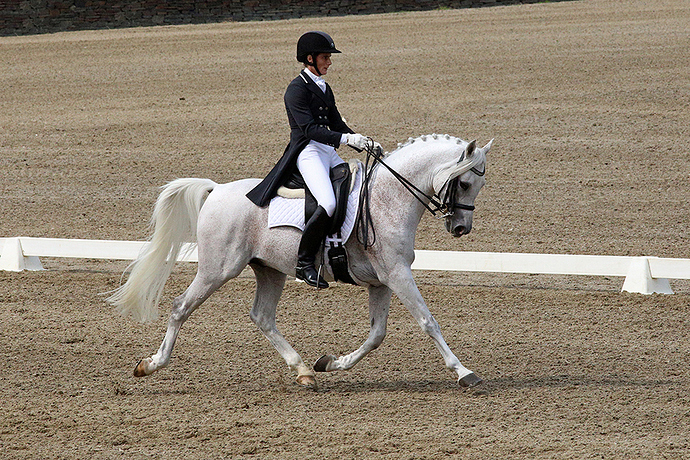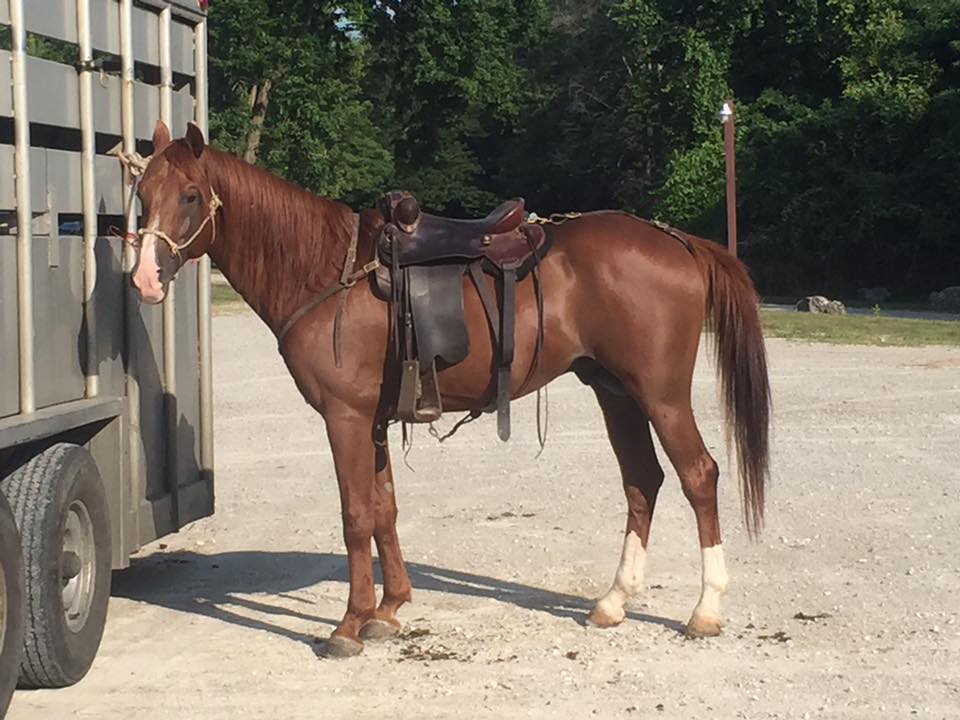I joke that I’m a lazy rider;). But honestly, lazy horses are more apt to expend more energy getting out of work than just doing the work, ime. Having worked at various barns, I can install a decent “go” button, but ideal match is one where I contain/direct the energy than create it. But I’m also getting older (not ancient yet, but aware of my age), so I do not want spooky. I can ride a buck but rearing is a deal breaker (have ridden some and just not an issue I want to tackle). So good brain but interested in the work. Basically, a sensible TB like my mare is my soulmate type.
Haflinger 
I’m in the camp of “the individual horse”.
I’ve ridden, met and seen TBs, QHs, Iberians, Welsh Cobs, German riding ponies, Fresians, Bashkir Curly’s, etc. go to GP with good training. But in each case the horse or the line was willing to work and that is the major consideration.
Many OTTBs are incredibly hot so if that is OK, look at OTTBs. There’s one at my barn right now that I would consider buying but he’s quite reactive. There is a double Hancock bred QH that I’m currently drooling over, as well as another palomino Paint I gave a huge green light to the owner to buy as a 2 year old who I tell everyone he wants to do dressage (oh his gaits and his mind as he’s been started at my barn!!!). And there are many unregistered WBs to consider who don’t have much of an asking price. Float a price to many and see who bites. Good luck!
So you know your type - concentrate on that. Plenty of TB, Appendixes etc that could be The One. Be open to other types, but be honest with yourself and don’t just pursue “good deals” that really aren’t going to make you happy. Horse hunting is frustrating regardless.
Ultimately, the breed is secondary to the physical and mental suitability for the work and how well the horse’s attitude and aptitude fit with your preferences. What size, shape, degree of forwardness and sensitivity do you prefer?
I switched from WBs to Arabians in the mid-90s when I sold a super talented but aggressive on the ground young KWPN gelding. My previous horse had been a TB with a kind generous temperament, so this gelding was just not fun for me no matter his athletic potential. I took on an untrained 15 year old Arabian mare as a fun project and just fell in love with her desire to please and her athleticism. When I discovered that her bloodline group was dwindling due to being too “old fashioned” for the breed show ring, I got interested in breeding them on a small scale in addition to riding them.
I enjoy the “handy” size of around 15 hands, but some of my best riding horses have been 14-14.1H with deep broad bodies and forward gaits so they feel bigger. Stick size is not something I obsess over at this point. (I’m 5’6")
What I like most about the lineages that I have is that they have great minds and work ethics as well as plenty of substance. I had one 14 H mare with 7 3/4" bone who was still very sound under saddle at 26. My 15 H stallion who will compete with his trainer at USDF shows this year at Intermediare II (on his way to GP) has 8" bone, my personal riding horse is 14.3H with 8 1/2" bone. These are not “dainty” Arabs. Real “working” type conformation. I’ve never been involved with the breed shows because my roots are in the all-breed world and that is where I am most comfortable participating.
I love that in my USDF region we have plenty of people on non-WBs. Fjords, Haflingers, Morgans, Arabians, TBs, PRE, Lipizzans, various stock breeds, draft crosses, etc. that all put in credible tests.
One of the bonuses of many of the smaller breeds (Morgans, Arabs, Welsh Cobs, etc.) is soundness. TBs (and WBs) are less reliable in terms of long term soundness, IME.
If you like TBs a lot you might consider looking at Anglo-Arabs. Another “hot-blood” breed that is less common is the Shagya-Arabian. They are largely Arabian in lineage crossed on a foundation of native Hungarian riding/cavalry horses with hundreds of years of selecting for cavalry/sport performance.
There are lots of options for you to consider. Knowing what qualities you want/need and seeking horses that fit that profile regardless of their breed will allow you to best explore those options.
(photo of Arabian competing at Intermediare I in 2020 (trainer riding)-- This stallion was given a score of 10 for character at the 70 day Stallion Performance Test with rideability and willingness scores of 9. A great mind is a big part of why I love these bloodlines. I want a deep partnership with my horses, so willingness, friendliness and a solid work ethic are really important to me.)
A trainer i know breeds a nice type of Arabian also/ Here is one of her stallions …bred here. that was imported back to Saudi Arabia to use as stud in a breeding program there. He is an accomplished athlete and a beautiful moving horse.
I cannot believe how often I read that before the penny finally dropped…
Ranch bred quarter horses or similar working type quarter horses would be my first choice. Second would be a mustang. However, I haven’t had one of either for dressage, personally. I’ve loved many of each type.
I agree that overall it’s dependent on the individual horse.
My young horse is a ranch-bred quarter horse and you would mistake him for a warmblood cross. He has lovely gaits and is very easy to ride. He just turned five and has a great temperament. If I were looking, I’d definitely check out the more sport-type quarter horses. I’ve seen a few that look more “baroque” as well.
To add to that, I have seen some Aztecas and Arab/QH crosses that were super fancy.
I have an Arab/Hano cross mare who is WONDERFUL- came from a backyard breeder and dirt cheap. She is solidly built, lovely movement, good brain, easy keeper with great feet. She can be too smart- she gets bored if I don’t keep her thinking!
Her progress has been limited by my lack of talent, but trainer has said she could easily go to 4th level. There was a definite subtext of “with the right rider…”! I get discouraged watching how lovely she looks with trainer on board, but we have fun together. Mare doesn’t mind not working to her potential.
I will say my last horse, and I think the love of my life, was a ranch type ( hancock) QH. He was never going to the Olympics, but a more amiable, happy, work positive horse you will never meet, He loved going to shows, he always tried. I do not think he ever made a sour expression or aggressive attitude. Very responsive, light to the aids, lateral work was simple, Medium trot was lacking in my hands but he always tried. Retired to be a well loved school horse with a trainer I respect. I will treasure him always.
I would be terribly remiss if I didn’t put a plug in for the Shagya Arabian.
This rare breed is incredible. They have all the best qualities of an Arab- intelligence, forward-thinking,
people-loving - rideable - trainable - all on a bigger frame with more bone and a little bit of a quieter
temperament. They range in size between 15 and 16.1 hands and have lovely movement - and they
are affordable.
For more information you can visit www.shagya.net
Some interesting breeds, but I guess I’m curious - are some of these rare breeds, like Lipizzaners or Shagyas, budget friendly options? Like, sub-$10K for nice prospect with no limits under age 10?
I can’t speak for Shagyas but can speak for Lipps. If you’re willing to buy a foal/very young, you can find them for <10k. If you know the right people, you can find a 10-15 year old with basic training for ~10k. Nice ones are pricy but breeders want to get people interested, BUT they’re also picky about where they go.
I think the issue isn’t price so much as just finding one (not to mention finding one you’re compatible with!) There is certainly a much larger pool of TBs and QHs to choose from!
(That being said, I grew up riding a Shagya in Hungary and that horse was amazing - carted around my crazy young self all over trails and jumping over whatever weird objects I stacked together, pulling a sleigh in the winter, and even doing some light plow work on my uncle’s farm - while also producing several babies in the meantime.)
I’m just on the periphery of the Shagya world, but the pricing seems to be 10K or under for nice prospects in most cases. As Training_Cupid said, the bigger challenge is probably locating them. There are two ISG recognized Shagya registries in the US: NASS at https://shagya.net/ and http://performanceshagyaregistry.org/
I’m pretty sure this lovely NASS Shagya filly is being retained by her breeder. The dam is an imported European Shagya mare that competed in Europe in FEI endurance. Sire is a US bred Arabian currently schooling I2.
I think it’s an underappreciated breed here in the US.
Seconding QH or appendix. You can find some really nice ones that are bigger bodied, not too downhill and a little too spicy for their AQHA HUS/eq job, but would make a lovely dressage prospect.
I’ve enjoyed a lot of QHs through the years, and many quite nice! With OTTB and ASBs, I know of reputable “rescues” to contact for prospects. How do you find the QH “wash outs”? Just regular sales ads? I’ve worked some OTQHs but they go (sell) quickly and not many in my location (I lived out west in the past). I’m also debating some of the Amish sales. I live near Amish country and there are auctions and breeders around. Interestingly, they aren’t that cheap, either!
Ranch bred quarter horses or similar working type quarter horses would be my first choice. Second would be a mustang. However, I haven’t had one of either for dressage, personally. I’ve loved many of each type.
I agree that overall it’s dependent on the individual horse.
I would also consider a ranch-bred QH. The trainer at my barn has a double Hancock QH (apparently, very “cowy”) who is not dull at all, has a higher-set neck, great withers connection, and a pretty great trot. I knew someone in Houston who took her QH to GP.
But I’d say really really investigate the individual mustang. Some herds have a lot of draft influence and wouldn’t be particularly suitable because they’re heavy and not quick. Some of the southern range mustangs have a lot of Paso Fino in them and while their necks look like they come out to the withers well and tie in well, they have almost no suspension. So many individual herds are a product of what domestic breed escaped or was “ditched” in the herd. I’ve seen some fabulous Mustangs in terms of attitude and movement, and I’d probably really research the herds to narrow your choices or really evaluate the individual it I wanted to go this route.
I would also really look at Arabians. My friend had a Polish Arabian stallion (great brain) and bred him to a Polish racing Arabian broodmare whom I believe was a NF Proof mare (I met him several times, my god he was friendly and had great movement!!!). The result was a horse she sent to Hilda Gurney who I think showed his through fourth level before she brought him back.



